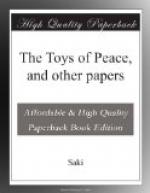“Do you remember the picture I showed you at Taunton?” he asked.
“Yes,” grunted Tom; “a white-faced bull standing in some slush. Don’t admire those Herefords much myself; bulky-looking brutes, don’t seem to have much life in them. Daresay they’re easier to paint that way; now, this young beggar is on the move all the time, aren’t you, Fairy?”
“I’ve sold that picture,” said Laurence, with considerable complacency in his voice.
“Have you?” said Tom; “glad to hear it, I’m sure. Hope you’re pleased with what you’ve got for it.”
“I got three hundred pounds for it,” said Laurence.
Tom turned towards him with a slowly rising flush of anger in his face. Three hundred pounds! Under the most favourable market conditions that he could imagine his prized Clover Fairy would hardly fetch a hundred, yet here was a piece of varnished canvas, painted by his half-brother, selling for three times that sum. It was a cruel insult that went home with all the more force because it emphasised the triumph of the patronising, self-satisfied Laurence. The young farmer had meant to put his relative just a little out of conceit with himself by displaying the jewel of his possessions, and now the tables were turned, and his valued beast was made to look cheap and insignificant beside the price paid for a mere picture. It was so monstrously unjust; the painting would never be anything more than a dexterous piece of counterfeit life, while Clover Fairy was the real thing, a monarch in his little world, a personality in the countryside. After he was dead, even, he would still be something of a personality; his descendants would graze in those valley meadows and hillside pastures, they would fill stall and byre and milking-shed, their good red coats would speckle the landscape and crowd the market-place; men would note a promising heifer or a well-proportioned steer, and say: “Ah, that one comes of good old Clover Fairy’s stock.” All that time the picture would be hanging, lifeless and unchanging, beneath its dust and varnish, a chattel that ceased to mean anything if you chose to turn it with its back to the wall. These thoughts chased themselves angrily through Tom Yorkfield’s mind, but he could not put them into words. When he gave tongue to his feelings he put matters bluntly and harshly.
“Some soft-witted fools may like to throw away three hundred pounds on a bit of paintwork; can’t say as I envy them their taste. I’d rather have the real thing than a picture of it.”
He nodded towards the young bull, that was alternately staring at them with nose held high and lowering its horns with a half-playful, half-impatient shake of the head.
Laurence laughed a laugh of irritating, indulgent amusement.




